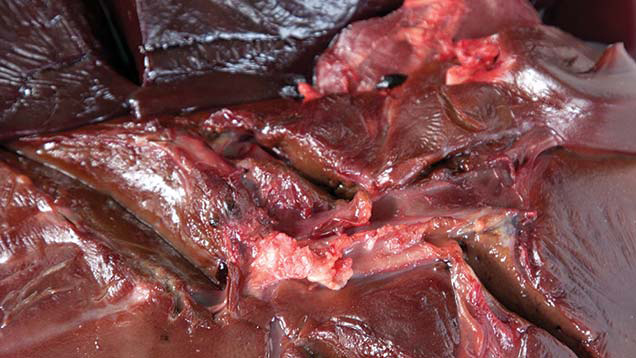How to treat liver fluke in cattle at housing to prevent losses
 © Tim Scrivener
© Tim Scrivener Farmers are being urged to implement a parasite management plan this autumn to prevent production and economic losses caused by liver fluke.
The warning comes after Food Standards Agency (FSA) collated data from abattoirs across Great Britain over the last 12 months, found that one in five cattle livers were damaged by fluke, with the majority occurring in January. It is estimated that such losses are costing farmers up to £30 a head.
See also: More worm control advice
Andy Forbes, Control of Worms Sustainably (COWS) technical representative, says it takes two to three months for the liver fluke to develop into adult fluke inside cattle, and the peak found in livers in January, which is a likely result of infections acquired in the autumn.
“Therefore, late summer and early autumn, traditionally known as a high-risk period for liver fluke, is a particularly key time for beef farmers to be proactive in terms of liver fluke management,” warns Dr Forbes.
Treatment advice
Prior to treatment, Dr Forbes says farmers need to be 100% clear what they are trying to achieve by using a flukicide. He says there are two reasons for a fluke treatment at or after housing.
- Removing fluke burdens will help cattle perform well over winter and achieve their potential in terms of growth and productivity.
- If cattle are to graze on-farm the following year, effective flukicide treatment over winter will ensure the cattle are not shedding fluke eggs in their dung on to pasture after turnout and will not contaminate pastures
Once the goal of treatment is clear, the choice of when to treat and with what is based on several factors, he says.
“These factors include whether resistance to any flukicide has previously been diagnosed on-farm, the class of cattle being treated and consideration of meat and milk withdrawal periods,” he says.
Dr Forbes explains treatment is also dependent on weather conditions.
He says this year there has been a marked split in weather patterns across the UK. “This year we’ve seen farmers in the North struggling to get cattle out due to the wet and cool conditions, while in southern England it has been almost drought like, at times, this summer.
“The weather in summer can determine the risk of fluke in the autumn as the snail hosts do not do well in dry conditions. It may be that liver fluke challenge is lower in some parts of the country, but if it was warm and wet in June and July, the challenge could be high.
“There is no one-size-fits-all approach to managing liver fluke on-farm, but implementing a parasite management plan based on recommendations from your vet or SQP, and following the COWS best practice guidelines will help reduce the economic and production losses associated with liver fluke,” says Dr Forbes.
Top tips for treating fluke at housing
- Make sure each does is accurately calculated before treated. This is only possible by weighing the cattle
- Check dose guns are properly calibrated
- Check withdrawal periods and follow the manufacturer’s guidelines
Table one: COWS liver fluke treatment options for cattle at housing
| Active ingredient* | Treatment options at housing – for any age stock |
| Triclabendazole (oral) | Delay treatment until two weeks after housing |
| Closantel
Nitroxynil Triclabendazole (pour-on) |
1. Treat at housing
2. Repeat treatment eight weeks later |
| Albendazole
Clorsulon Oxyclozanide |
1. Treat at housing
2. Repeat treatment 12 weeks later |
NB: No products have persistent activity
